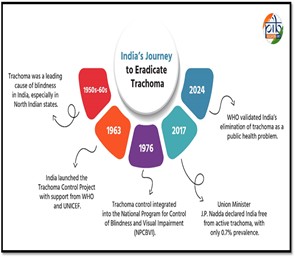India Eliminates Trachoma as Public Health Threat
India Eliminates Trachoma as Public Health Threat
Why in the News?
In a significant development for national news of India and public app news, India received the WHO certification for the elimination of Trachoma as a public health problem during the 78th World Health Assembly in Geneva. This achievement marks a major success in public health policies and the National Program for Control of Blindness and Visual Impairment (NPCBVI). The elimination of trachoma, a topic often featured in trachoma UPSC discussions, highlights India’s progress in addressing national health problems in India and eye diseases in India, including new eye diseases in India that continue to emerge. This success also paves the way for addressing potential new eye disease in India that may arise in the future, adding trachoma to the list of diseases eradicated in India. The achievement has been widely reported on various platforms, including DD health, which has been instrumental in disseminating crucial health information to the public.
Global Recognition and Public Health Achievement:
- India certified by WHO for eliminating Trachoma as a public health problem, joining the list of WHO eliminated diseases and showcasing successful disease eradication efforts in India. This achievement adds India to the public health list of countries that have successfully eliminated major health threats, demonstrating the effectiveness of its Verifiable Digital Health Certificates It’s worth noting that this milestone comes decades after Indira Gandhi became the first woman PM of India, showcasing the country’s continuous progress in various fields.
- Officially declared on October 8, 2024.
- Recognition awarded at the 78th World Health Assembly, Geneva, in May 2025, where India’s success was highlighted alongside discussions on the Global Digital Health Certification Network. The GDHCN Secretariat praised India’s efforts in integrating digital health solutions with public health initiatives.
- India becomes the third country in Southeast Asia to achieve this milestone in disease elimination in India, addressing one of the significant India’s health challenges. This success sets an example for other endemic countries still battling active trachoma.
National Interventions and Surveys
- Elimination driven by the National Program for Control of Blindness and Visual Impairment (NPCBVI), demonstrating effective strategies in combating national health problems in India through digital governance and innovative health initiatives, including the implementation of Public Key Infrastructure for secure health data management. The program’s success has been linked to improvements in overall food security architecture, recognizing the connection between nutrition and eye health.
- Since 2019, a continuous effort has been made to eliminate trachoma, an infectious eye disease caused by Chlamydia trachomatis that can lead to trichiasis, corneal scarring, and blindness if left untreated.
- The SAFE strategy (Surgery, Antibiotics, Facial cleanliness, and Environmental improvement) was implemented as part of the trachoma treatment protocol, following SMART Guidelines for efficient implementation. This approach incorporated elements of Trust Domains and Trust Network Gateway to ensure data privacy and security. The onboarding process for healthcare providers and patients was streamlined to ensure widespread participation.
- Interventions included mass drug administration of antibiotics, improved water and sanitation facilities, and environmental improvement measures. These efforts were supported by digital health initiatives similar to the Digital Documentation of COVID-19 Certificates, drawing inspiration from the EU Digital Covid-19 Certificates system for efficient health data management.
- Rigorous surveillance and impact surveys were conducted to monitor the prevalence of active trachoma and assess the effectiveness of interventions. Pre-validation surveys were crucial in demonstrating India’s readiness for WHO certification. The surveys utilized advanced data management techniques based on HL7 FHIR specifications to ensure accurate and standardized reporting.
- The success of these interventions not only led to the elimination of trachoma but also significantly contributed to overall blindness prevention efforts in India, showcasing the country’s commitment to improving eye health and tackling new eye diseases in India.
This achievement in eliminating trachoma as a public health problem demonstrates India’s commitment to addressing national health challenges and sets a precedent for future disease eradication efforts. The success of the NPCBVI in implementing effective strategies and leveraging digital health technologies paves the way for tackling other public health issues and emerging eye diseases in the country.




